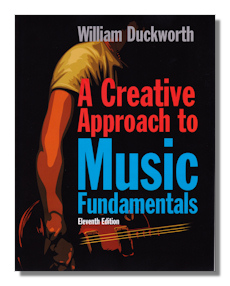
The Internet's Premier Classical Music Source
Related Links
-
Introduction
Acoustics
Ballet
Biographies
Chamber Music
Composers & Composition
Conducting
Criticism & Commentary
Discographies & CD Guides
Fiction
History
Humor
Illustrations & Photos
Instrumental
Lieder
Music Appreciation
Music Education
Music Industry
Music and the Mind
Opera
Orchestration
Reference Works
Scores
Thematic Indices
Theory & Analysis
Vocal Technique
Search Amazon
Recommended Links
Site News
 Book Review
Book Review
A Creative Approach to Music Fundamentals

William Duckworth
Schirmer (11th edition, 2012), pp xxi + 385
ISBN-10: 0840029993
ISBN-13: 978-0840029997
William Duckworth's A Creative Approach to Music Fundamentals is a comprehensive, well-conceived and well-written and produced book covering the basics of music theory. Now in its eleventh edition, it will be of use to many types of listeners who feel the need either to brush up on what they have learnt previously – in school music classes, perhaps; and/or to approach the dozen or so topics which it covers from scratch.
These are:
- musical basics and keyboard layout
- simple meter
- compound meter
- the principles of pitch
- major scales
- major key signatures
- intervals
- minor key signatures
- minor scales
- pentatonic and "blues" scales
- triads
- chord progressions
The style of background information, explanations, "tips", the way Duckworth is aware of likely problems and deals with the many questions commonly asked by the reader/learner in exercises are all clear and authoritative. Duckworth is an expert and often finds ways to triangulate on trickier topics in such a way that the potentially puzzled student can benefit.
Most users will have areas and aspects of music theory which may remain troublesome. These may be remembering the order of sharps or flats, how to deal with inversions, or intervals. Duckworth is at pains to anticipate these and make his explanations and illustrations as clear as possible. The book also has a short glossary and index. There are diagrams aplenty and intelligent use of color and typographical conventions that not only distinguish how material is covered within any one chapter or section; but also actively guide readers through the book.
It must be noted that A Creative Approach to Music Fundamentals is intended for class, group or course study with a tutor or leader. Although it's possible to follow the material in the book on one's own, if you plan to do all the exercises and work through the subject matter in the way intended, you'll miss much without the interactivity (playing sample exercises, in particular, guided ear-training, too) that comes along with having an expert to call on. It's definitely an approach that emphasizes testing and exercises as much as pure explanation. Users who thrive on filling in tables, completing examples, writing in answers to questions posed on material just presented – always in context, but sometimes squarely in the flow of new and developing narrative and exposition – will find that the book works well for them. There are no keys/answers in the book: the instructor or teacher really is at the center of things in this respect.
A Creative Approach to Music Fundamentals is very well laid out… crisp, clear musical examples, plenty of white space, and attractive page design with sidebars and panels that make working through any one chapter far from daunting. Each chapter or section tells you at the start what you are going to learn, the material it will cover; the material is presented; additional tips are highlighted; there are then class practice and exercises.
In addition to a laminated foldout card keyboard, there is a companion website (Cengage "CourseMate"), access to which is limited to a certain period of time once you register – so it's expected that you'll complete the book within a definite timeframe. Sufficiently clear and well thought-out, though, is the substance of A Creative Approach to Music Fundamentals that this is not likely to defeat most users. Here too, it's expected that you're affiliated with a school or other (learning) institution.
At under 400 pages, this can't be so comprehensive a book as some which have been reviewed on Classical Net. But for a useful summary and introduction which covers the ground that most musicians accept is essential, it does its job very well.
Copyright © 2013 by Mark Sealey.



















